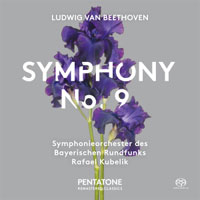Beethoven • Symphony No.9
 nother Beethoven Ninth? Why add to
my collection when I have half a dozen recordings of it already? This is a fair question
to ask about most works, but this is not "most works." Beethoven’s last
symphony is one of the supreme masterpieces of the classical repertoire and at the same
time it is one of the most loved pieces of symphonic music. From at least his teens,
Beethoven was under the spell of Friedrich Schiller’s poem "An die Freude"
("Ode to Joy"), and by his mid-teens he was creating sketches for a setting of
the poem and struggled throughout his life with the massive task of creating music as good
as the poem. Over a period of 11 months beginning around April 1823, Beethoven came up
with the opening phrase for the poem’s setting in the final movement and then worked
backward to compose the symphony around it. nother Beethoven Ninth? Why add to
my collection when I have half a dozen recordings of it already? This is a fair question
to ask about most works, but this is not "most works." Beethoven’s last
symphony is one of the supreme masterpieces of the classical repertoire and at the same
time it is one of the most loved pieces of symphonic music. From at least his teens,
Beethoven was under the spell of Friedrich Schiller’s poem "An die Freude"
("Ode to Joy"), and by his mid-teens he was creating sketches for a setting of
the poem and struggled throughout his life with the massive task of creating music as good
as the poem. Over a period of 11 months beginning around April 1823, Beethoven came up
with the opening phrase for the poem’s setting in the final movement and then worked
backward to compose the symphony around it.
No single performance of this music does it full justice, nor could it be expected that a single performance would extract all of Beethoven’s magic. I had an even dozen Ninths before this one arrived, and even accounting for duplicates of the same recording on LP and CD, I still had ten different performances. And that doesn’t count the one I culled from the full set of Beethoven symphonies, conducted by Wojciech Rajski, that I reviewed. Rafael Kubelík was a Czech-born conductor and composer who recorded a vast repertory during the 1960s and 1970s, much of it for Deutsche Grammophon, including two traversals of the Beethoven symphonic cycle. This recording is a reissue of Kubelík’s 1975 quadraphonic recording made in the Herkulessal at the Residenz in Munich, Germany, and released as a stereo boxed set in 1976. Pentatone licensed the recording from Deutsche Grammophon and remastered it in 2017 for this SACD release. Kubelík’s reading clocks in at almost 70 minutes, fairly common for the time period, but very measured by the current "authentic" movement standard. By comparison, Philippe Herreweghe’s 2009 performance [Pentatone PTC 5186 317] shaves nine minutes off that mark. In his classic 1957 live performance at The Royal Festival Hall, Otto Klemperer, famous for his very relaxed pace in most performances, takes only 71 minutes to do justice to the Ninth. Even with its shorter running time, there is nothing
mannered about Kubelík’s reading, which is both dramatic and detailed. Like
Karajan’s 1963 performance, this one emphasizes clarity of orchestral voices over
speed. With a piece of music this familiar, there are phrases embedded in your mind that
stand out -- tympani strikes, entrances of woodwinds and phrasing of horns. With
Kubelík’s reading of the Ninth, as with any great interpretation of a familiar work,
I found myself at first focusing on such dramatic touches, especially the sound of the
horns, which seemed to stand out. Kubelík coaxes something unique from the horn entrances
that, combined with the fine acoustics of the Residenz, help push this recording and
interpretation far above the crowd of Beethoven Ninths. This recording, and a handful of
others I own that were made at the Residenz, make me long to hear a live performance in
that venue. |
